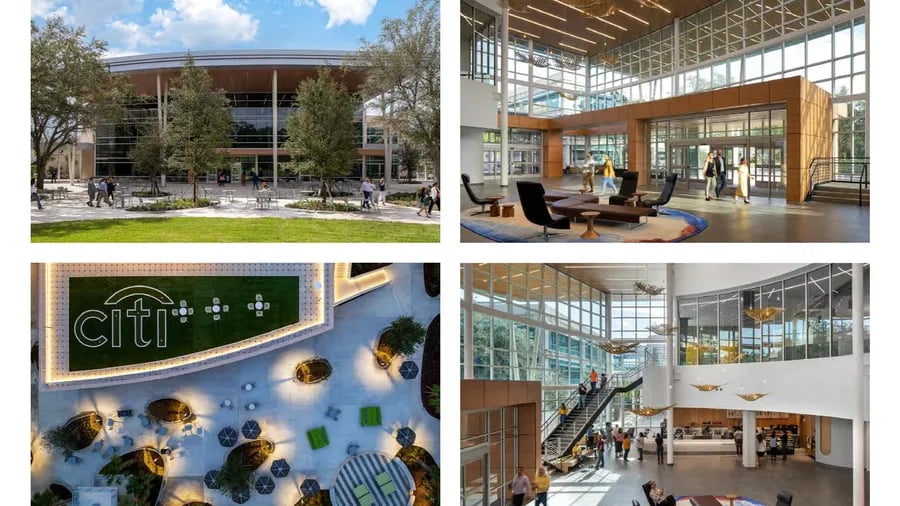Pretty much everybody agrees that employee collaboration has taken on a new meaning. Of course, this has created quite a rocky office market. But, if you look closer at the data, you’ll see that the offices that are struggling are not the premium Class A properties, it’s the old and outdated offices that are witnessing rampant vacancies.
Because, to maximize human interaction and engagement in hybrid settings, companies are now investing in their portfolios differently, with more emphasis on creating an environment that is worth the potential commute. Let’s call it a quality over quantity epidemic.
So, what does this mean for the office of the future and the evolving role of corporate space? Well, let’s look at Citi Bank’s major Tampa redesign as an example. With the goal of investing in a collaborative workplace that prioritized employee well-being, the company took deliberate steps to ensure their campus is future-proofed and value-facing. And they put their money where their mouth is to achieve this, laying down $60 million for the new and improved facility.
Let’s take a look at Citi’s upgrade choices and how they represent greater trends in the CRE space.
Invest in Promising Locations
First and foremost, it’s worth mentioning that the facility in which Citi poured tens of millions of dollars into corporate upgrades, is located in Florida. Now, this shouldn’t be too shocking considering that the corporate migration to Florida is well into its third year. Citi is one of hundreds of businesses that expanded or relocated their corporate footprint in the state since the beginning of the pandemic.
|
“We’re growing and [Tampa] has been and continues to be a strategic center for Citi, certainly in North America and globally.” Citi managing director and Tampa site leader Nick DellaSerra. |
What is a little more scandalous to consider though, is that Citi is headquartered in New York. So rather to choosing to invest in its current footprint there, Citi selected Tampa for an expensive and updated campus redesign… And when you hear about some of the features on the 137,000 square feet campus a little later on, you can guess how unaffordable it would be in a high-cost city like New York.
If we solely take a look at the difference in base rent Citi is experiencing, In Tampa, for example, Class A office rents are around $36 per square foot, which is a very attractive value compared to Manhattan where average is closer to $80 per square foot. Let’s use the average numbers for some estimation on what Citi would save in 1, 5, and 10 years simply by being located in Tampa.

Simply put, corporate dollars go further, a lot further. Over a ten-year lease Citi is saving themselves $60 million. And because they have such a lower overhead, they’re funneling the extra capital into upgrades that strengthen its relationships with its employees.
Tampa proved to be wiser investment for corporate funding than New York. Because they’re not just saving in rent either. Florida has a lower tax-burden, less restrictive business environment, and overall more affordable living costs. Learn the other reasons Why Businesses are Moving To Florida.
If you're considering a Florida relocation or expansion, you should know that this is what we do. We’re licensed and experts in finding you the right space in Florida or any other state. Check out our corporate migration series if you're still curious.
Create a Welcoming Environment
The 137,000 square feet campus in Tampa also rethinks the norm of the office place. Citi gave employees the option for more work-life freedom with a hybrid schedule. Rather than force employees into the office, they invested in upgrades that make it into a compelling place for collaboration. This is proving once again that businesses do believe in the value of the office place, but they're being more selective about CRE spending to maximize the employee experience while still streamlining portfolios.
|
“It provides flexibility to have better work-life balance but we also stressed the importance of being in the office because we’re better together.” Citi managing director and Tampa site leader Nick DellaSerra. |
The emphasis is now on cultivating a welcoming environment. And this is important because, despite how nice an office may be, employees still prefer to have the option to work from home. According to Shark Tank's own Kevin O’Leary, “40% of the staff approximately are never coming back to the office and if you think you can force them back, they’re just going to work for somewhere else.”
So Citi Bank is smart. It’s listening to the preferred working schedules of its employees and adapting itself around that. They redesigned according to the needs of its people and what they were looking to get out of an office space. This includes more open spaces where employees are free to collaborate, socialize, and work comfortably.
 New Citi campus in Tampa, The Tampa Bay Times
New Citi campus in Tampa, The Tampa Bay Times
“There are places where people can go and grab a coffee, sit down and speak, all those things, promote, working together in an in-person environment that frankly, the feedback from our staff has been it’s been very refreshing that not only can they work together with their colleagues which they hadn’t been doing during the pandemic, but they’re able to do so in such a pleasant setting with all the amenities that we just discussed," said Citi managing director and Tampa site leader Nick DellaSerra.
This is also part of the trend of offices adopting more of a hospitality rather than a workplace mentality. So the campus attempts to provide features that go above and beyond what’s expected of a normal day at the office. And what does this include? How about a large cafeteria with an extensive list of food options? And, get this, if you don’t know what to eat you can visit the in-house nutritionist. It’s obvious Citi is investing in employee wellness because beside these features, the campus has more natural light, medical and fitness centers and on-site physical therapists!
Leverage Technology in the Workplace/ Redefine Norms
Redefining the norm of the workplace also means accommodating those working from home three out of the five days in a week. The modern office is smarter about utilization, providing more open collaborative spaces than enclosed cubicles.
Because in a hybrid-friendly office, workflows look a little different than the pre-covid workplace. And this is happening with businesses everywhere, in fact by 2025, corporate workspace allocation will flip from 70% individual workstations and 30% collaborative space to 30% individual and 70% collaborative space-GlobeSt.
So the new office has to provide space for hybrid collaboration, where employees in-office can rendezvous with coworkers working from home or across the country.

Because of this, the next level of upgrades Citi undertook is updating its conferencing facilities. Technological integration is now a foremost concern for businesses, and this is reflected in investing more in advanced software and cutting edge tech. For conference rooms, this can look like AI cameras that provide a more in-person feel for at-home meeting attendants, high-quality audio features, and other equipment that supports a largely digitally-based workforce. Learn How to Create a Hybrid-Friendly Conference Room.
By offering such facilities and spaces, it fosters an environment that encourages collaboration, optimizing the productivity of individuals when they come together. Consider it an investment in future-proofing.
What Tenants Can Learn
The changing landscape of employee collaboration has undoubtedly impacted the office market, but it has also presented unique opportunities for businesses willing to adapt. As demonstrated by Citi Bank's major Tampa redesign, investing in a collaborative workplace that prioritizes employee well-being can yield significant benefits.
By choosing promising locations like Tampa, businesses can take advantage of lower costs and favorable market conditions. The cost savings in rent alone can be substantial, allowing companies to allocate more resources towards enhancing employee experiences and strengthening relationships.
Because, creating a welcoming environment that encourages collaboration and work-life balance has become paramount. Companies like Citi are redefining the norms of the workplace by offering open and flexible spaces, leveraging technology for hybrid collaboration, and providing amenities that go beyond the traditional office setting. These strategic investments not only future-proof the office but also attract and retain top talent. In this rapidly evolving business landscape, being proactive, adaptable, and investing in the right office spaces can set businesses on a path to growth and success.
These considerations and more should be utilized to find your best office hybrid-friendly space. Learn the other steps corporate tenants need to take to know which properties suit their interests for the optimal price in the free course below.








